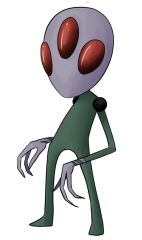What Color Hair Do They Have? Talking about ‘Dath Gruaige’ in Irish Posted by róislín on Jun 5, 2015 in Irish Language
(le Róislín)

Nil an oiread is ribe gruaige orm. Ach tá trí shúil agam! An Marsach mé nó an eachtardhomhandach de shaghas éigin eile mé? Do bharúil? (grafaic: http://www.clipartlord.com/category/space-clip-art/page/4/)
Recently we’ve been looking at “dath gruaige” (hair color) in Irish, emphasizing “fionnrua” (“strawberry” or “Venetian” blond) and, because of the emoji issue, “rua” (red). We also practiced some of the other typical colors: donn, dubh, and liath.
With phrases like “fear donn” or “bean fhionnrua” [ban IN-ROO-uh, silent “fh”], we’re using the hair color in the same phrase as the subject (the man, the woman, or whoever). In this blog post, however, we’ll look at how to say “He has brown hair” or “She has red hair.”
The key issue here is what to do about the word “has.” As you may recall, Irish often uses very different expressions where English uses “have” or “has.” For example, if you have a headache, you say, “Tá tinneas cinn orm,” lit. “There is a headache on me.” Also, if we are hungry, we say “Tá ocras orm,” lit. “Hunger is on me.”
We use the same structure for saying what color hair someone has. The hair color is “on you.” So, to say what color hair someone has, we use different forms of the word “ar,” the word for “on” (orm, ort, air, uirthi, orainn, oraibh, orthu). If we actually specify the person by name or refer to him/her as “the man,” “the woman,” etc., we use the basic form, “ar” as in “ar an bhfear” or “ar an mbean,” or “ar Sheán.”
One more point before we start our examples. After the word “gruaig,” we have lenition (séimhiú) of the adjective, since “gruaig” is grammatically feminine. So “brown hair” becomes “gruaig dhonn,” with “donn” (brown) changing to “dhonn“.
Here are some examples:
Tá gruaig dhonn orm.
Tá gruaig fhionnrua ort.
Tá gruaig fhionn uirthi.
Tá gruaig liath air. (no change in spelling for “liath” since it starts with the letter “l”)
Tá gruaig rua orainn (again, no change in spelling for “rua” because “r” doesn’t take lenition; there’s no “rh” combination in Irish)
Tá gruaig dhubh oraibh.
Tá gruaig órdhonn orthu. (no change to the word “órdhonn” since it starts with a vowel; “órdhonn” is translated as “auburn” but it literally means “gold-brown”)
Now let’s think of some easily recognizable celebrities or fictional characters and see what color hair they have or had. There’s also a blank space in each sentence for you to fill in; there may be some duplicates in the answers. Freagraí thíos:
Little Orphan Annie: Bhí gruaig rua _____________________.
Rupert Grint / Ron Weasley: Tá gruaig rua _______________.
Yvonne, Annette, Cécile, Émilie, agus Marie Dionne: Bhí gruaig dhonn ________ nuair a bhí siad óg. Tá Annette agus Cécile beo fós, thart fá ochtó bliain d’aois; is dócha go bhfuil gruaig liath _________ anois (an freagra céanna sa dá bhearna).
Nicole Kidman: Tá gruaig ___________ uirthi (cé go n-athraíonn sí an dath ó am go ham).
Mona Lisa: Tá gruaig ___________uirthi.
Marsaigh (neacha ón bpláinéad Mars): Níl a fhios againn agus b’fhéidir go mbeadh gruaig ghlas (nó uaine) ________ (dá mbeadh gruaig ar bith ________)
Bhí gruaig fhionn ___ Phyllis Diller ach amanna bhíodh bréagfholt gorm uirthi. “Gorm,” a deir tú? Muna gcreideann tú mé, féach air seo: http://www.mycostumewigs.com/phdiblwig.html
Tá súil agam gur bhain tú sult as sin. An féidir leat scríobh isteach ag rá cén dath atá ar ghruaig an aisteora is fearr leat? Nó ar ghruaig an charachtair litríochta is fearr leat? Bheadh sé go deas bhur bhfreagraí a fheiceáil. SGF — Róislín
Freagraí:
Little Orphan Annie: Bhí gruaig rua uirthi.
Rupert Grint / Ron Weasley: Tá gruaig rua air.
Yvonne, Annette, Cécile, Émilie, agus Marie Dionne: Bhí gruaig dhonn orthu nuair a bhí siad óg. Tá Annette agus Cécile beo fós, thart fá ochtó bliain d’aois; is dócha go bhfuil gruaig liath orthu anois (an freagra céanna sa dá bhearna).
Nicole Kidman: Tá gruaig fhionnrua uirthi (cé go n-athraíonn sí an dath ó am go ham).
Mona Lisa: Tá gruaig dhonn uirthi.
Marsaigh (neacha ón bpláinéad Mars): Níl a fhios againn agus b’fhéidir go mbeadh gruaig ghlas (nó uaine) orthu (dá mbeadh gruaig ar bith orthu!). Here we could have a lengthy discussion of “glas” (green, usually in nature) vs. “uaine” (green, usually for man-made things). But what would that answer be for Martians? If Martians actually have hair, maybe green would then be a natural color, so “glas,” but if Martians are mainly a construct in our own imaginations, then maybe “uaine” (man-made green). However, that potential blagmhír will have to wait for am éigin eile.
Bhí gruaig fhionn ar Phyllis Diller ach amanna bhíodh bréagfholt gorm uirthi. “Gorm,” a deir tú? Muna gcreideann tú mé, féach air seo: http://www.mycostumewigs.com/phdiblwig.html

Build vocabulary, practice pronunciation, and more with Transparent Language Online. Available anytime, anywhere, on any device.




Leave a comment: